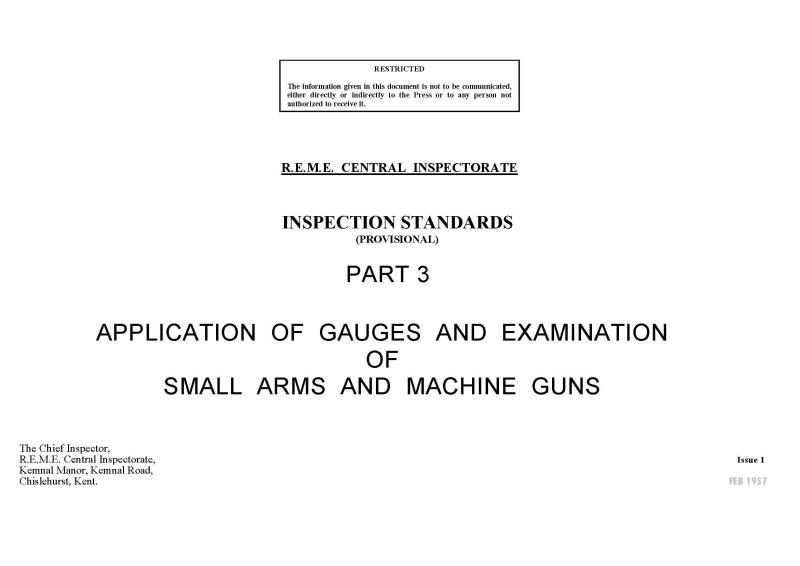-
Legacy Member

Amount of play on No4 Mk1 bolts
Hello,
I was examining 2 No4 Mk1s today, and I noted that there was a bit of "wiggle" or play as the bolt was slid back and forth. I can understand that a little bit of play is necessary to prevent the bolt binding as it moves, but how much is too much?
Information
 |
Warning: This is a relatively older thread
This discussion is older than 360 days. Some information contained in it may no longer be current. |
|
-
-
08-03-2009 02:22 AM
# ADS
Friends and Sponsors

-
Banned

If you mean front to rear (push – pull) the amount of movement is governed by the amount of headspace or head gap clearance you have (the air gap between the rear of the case and the bolt face. Without a case in the chamber the movement will be much greater and if your extractor spring is weak you will notice this movement to a greater extent.
If you mean side to side movement (right to left) that depends on the amount of wear in the bolt raceway and the wear and diameter of the bolt body. The only thing you can fix here is if the bolt diameter is under .880 and then the bolt could be replaced. You can not fix or repair the bolt raceway diameter in the receiver as it would normally be scrapped if oversized and worn beyond limits.
Read the Enfield manual below for inspecting your Enfield
1991 No.4 (All Marks) .303 Rifle Maintenance Instructions
http://photos.imageevent.com/badgerd.../No4Mk1Arm.pdf
Additional information came from the inspection standards below.

Last edited by Edward Horton; 08-03-2009 at 04:38 AM.
-
-
Legacy Member


Originally Posted by
spinecracker

Hello,
I was examining 2 No4 Mk1s today, and I noted that there was a bit of "wiggle" or play as the bolt was slid back and forth. I can understand that a little bit of play is necessary to prevent the bolt binding as it moves, but how much is too much?
I'm guessing you mean sideways 'sloppiness' as you pull the bolt backwards (as if to take it out of the action).
It may not be correct, or 'by the book' but I work on the principle that if there is no 'sloppiness' when the bolt is 'closed and locked' against the lugs then its OK.
All my Enfields (even the Enforcer which will NOT have fired many 1000s of rounds) exhibit a bit of sideways-slop if you wiggle the bolt about when it is 'open'.
No doubt someone will now tell me I'm dicing with death and the rifles should be destroyed.
-
-
Banned

Actually the “wiggle room” is to keep the mud of Flanders fields from jamming the bolt action on the Enfield Rifle , if you want a really tight action buy a M-16/A4 and watch it jam when it get dirty.
, if you want a really tight action buy a M-16/A4 and watch it jam when it get dirty. 
-
Legacy Member

I was thinking that sufficient side to side play was necessary to prevent jamming when dirty  . It is typical that, in my youth, I applied to get into REME as an apprentice gunfitter, but they stuck me in RAMC instead (Rats After Moldy Cheese or Rob All My Comrades spring to mind). 25 years later, I am a doctor who is interested in british guns, so perhaps I can follow both passions lol. Thank you for the REME specs - I am a nut when it comes to technical documents (it is soooooo sad....)
. It is typical that, in my youth, I applied to get into REME as an apprentice gunfitter, but they stuck me in RAMC instead (Rats After Moldy Cheese or Rob All My Comrades spring to mind). 25 years later, I am a doctor who is interested in british guns, so perhaps I can follow both passions lol. Thank you for the REME specs - I am a nut when it comes to technical documents (it is soooooo sad....)
-
-
FREE MEMBER
NO Posting or PM's Allowed

"I am a nut when it comes to technical documents (it is soooooo sad....)"
--spinecracker
We have Mr. Horton...invaluable!
Brad
-
Legacy Member

You have no idea. One of my interests is the British Navy from 1793 to 1815, and I spent 6 months locating PDF copies of records from that time - logs, biographies, navigation tests, naval architecture, etc - and when I finished, I worked out it would take me 10 years to read everything I found lol.
Navy from 1793 to 1815, and I spent 6 months locating PDF copies of records from that time - logs, biographies, navigation tests, naval architecture, etc - and when I finished, I worked out it would take me 10 years to read everything I found lol.
-
-
Legacy Member

How much is too much?
There would be a maximum bore for the receiver and a minimum diameter for the bolt body specified in the engineering drawings. This would be called the LMC or least materials condition. These are a natural result of having tolerances for manufactured/machined components.
The design engineer may also design in extra clearance at maximum material condition or MMC. MMC is the largest diameter bolt and the smallest diameter bore. At this condition the design engineer has to make sure a slightly crooked bolt & bore will still function since no manufacturing process always produces parts with perfect form. The extra clearance at MMC would be clearance for burrs, nicks, dirt, brass shavings, powder granules and other crud.
When a bolt is open and retracted there is a minimum length of bore guiding the bolt body. This permits a much greater wiggle at the end of the bolt due to the length of the bolt body magnifying the clearance. I doubt there is any specification that quantifies this wiggle.
On the other hand the little old man that makes rifles between his toes in Pakistan could probably find a way to adjust his bolt wobble with a vise if he had a vise or a rock and a big hammer. (Not to say that is the official way it should be done.)

Originally Posted by
spinecracker

Hello,
I was examining 2 No4 Mk1s today, and I noted that there was a bit of "wiggle" or play as the bolt was slid back and forth. I can understand that a little bit of play is necessary to prevent the bolt binding as it moves, but how much is too much?
-
-
Banned

Last edited by Edward Horton; 08-03-2009 at 09:51 PM.
-
It might amuse you to know that when we were manufacturing new P-40 fuselages there were many times that we found errors in the blueprints as they either did not quite add up dimensionally or did not match the existing original parts/ assemblies. Fixturing was made rather easier using original stuff combined with a slew of photos of the old Curtiss plant! Just using the old documentation was not enough by a long shot. Fortunately, its much better w/ the new engineering.
-















 PM
PM











 . It is typical that, in my youth, I applied to get into REME as an apprentice gunfitter, but they stuck me in RAMC instead (Rats After Moldy Cheese or Rob All My Comrades spring to mind). 25 years later, I am a doctor who is interested in british guns, so perhaps I can follow both passions lol. Thank you for the REME specs - I am a nut when it comes to technical documents (it is soooooo sad....)
. It is typical that, in my youth, I applied to get into REME as an apprentice gunfitter, but they stuck me in RAMC instead (Rats After Moldy Cheese or Rob All My Comrades spring to mind). 25 years later, I am a doctor who is interested in british guns, so perhaps I can follow both passions lol. Thank you for the REME specs - I am a nut when it comes to technical documents (it is soooooo sad....)







